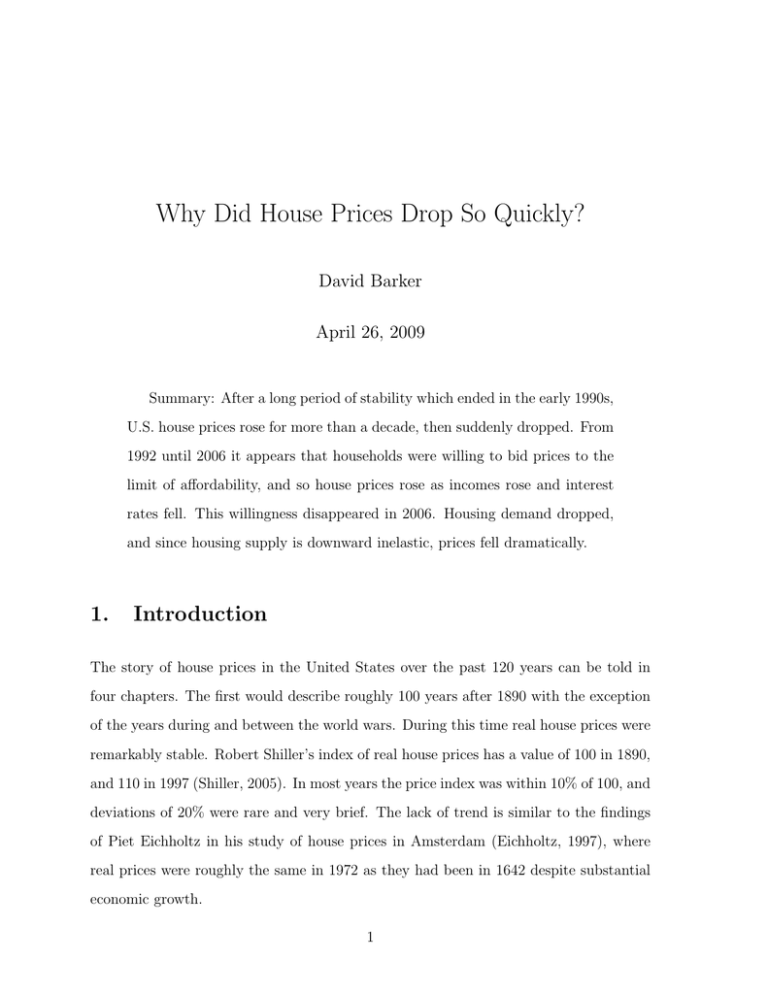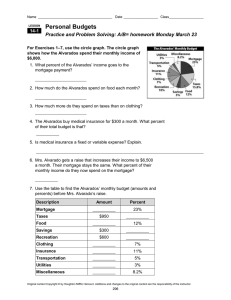Why Did House Prices Drop So Quickly?
advertisement

Why Did House Prices Drop So Quickly? David Barker April 26, 2009 Summary: After a long period of stability which ended in the early 1990s, U.S. house prices rose for more than a decade, then suddenly dropped. From 1992 until 2006 it appears that households were willing to bid prices to the limit of affordability, and so house prices rose as incomes rose and interest rates fell. This willingness disappeared in 2006. Housing demand dropped, and since housing supply is downward inelastic, prices fell dramatically. 1. Introduction The story of house prices in the United States over the past 120 years can be told in four chapters. The first would describe roughly 100 years after 1890 with the exception of the years during and between the world wars. During this time real house prices were remarkably stable. Robert Shiller’s index of real house prices has a value of 100 in 1890, and 110 in 1997 (Shiller, 2005). In most years the price index was within 10% of 100, and deviations of 20% were rare and very brief. The lack of trend is similar to the findings of Piet Eichholtz in his study of house prices in Amsterdam (Eichholtz, 1997), where real prices were roughly the same in 1972 as they had been in 1642 despite substantial economic growth. 1 The second chapter would cover the years from 1916 to 1945. Prices fell 30% in the four years from 1916 to 1920, remained fairly stable for 25 years, and then rose to their previous level very quickly, rising 33% from 1943 to 1946. The drop was probably due to the effects of World War I and the 1918 flu pandemic, while the increase was probably due to rapidly rising housing demand of returning World War II veterans. The third chapter would begin in the early 1990s. There was no expectation at that time of a general housing boom, in fact, two prominent economists had just predicted that housing prices would fall substantially over the next several years (Mankiw and Weil, 1989). House prices, however, began a period of remarkably large and steady increases; the OFHEO index of house prices increased by 57% between 1994 and 2006.1 Nominal prices more than doubled over this period, and in the largest cities of the U.S. they tripled. Since mortgage debt is owned in nominal dollars, nominal price increases produced tremendous capital gains for millions of Americans. The fourth chapter, of course, would describe the rapid fall of house prices which began in 2006 and is still taking place in 2009. 2. The Boom of 1992-2006 The most remarkable aspect of national housing prices from 1992 to 2006 is the stability of a very simple relationship; the ratio of mortgage payments to income. I define mortgage payments as the 30 year fixed mortgage rate multiplied by the mean house 1 There are three commonly used indices of house prices for recent years. One is published by the National Association of Realtors (NAR), another by the Office of Housing Enterprise Oversight (OFHEO), and another by Standard & Poors which is known as the Case-Shiller index. The NAR index is an average of all transactions, while the other two use a repeat-sales methodology to avoid composition bias. The Case-Shiller index covers only the largest 20 cities in the U.S. (the largest 10 from 1987 to 2000) while the other two are nationwide. The OFHEO index relies in part on appraisals, while the Case-Shiller index is based entirely on transactions. 2 price.2 Income is defined as real disposable income per capita, multiplied by average household size. During this period the ratio was confined to an interval between 24% and 16%. While there was some movement in the ratio, it tended to revert to a mean of approximately 20%, and was usually between 19% and 21%. This was unusual by historical standards; in 1975 the ratio was 30%, in 1981 it reached 57%, in 1985 it was 35%, and in 1990 it was 30%. Housing prices during this period appear to have behaved according to a very simple model where house buyers bid prices up to a limit of affordability. In this case the limit was a point where mortgage payments were roughly one fifth of household income. As mortgage interest rates fell, house prices rose; when rates moved up, prices fell. As incomes rose, house prices rose. An implication of this model is that if housing supply is a linear function of house prices, then housing construction will be a linear function of the ratio of income to interest rates. To see this, assume that the supply curve for new house construction is linear and upward-sloping. In the example below, current supply is 100 million units and the current price is $200,000. Each additional million units that the construction industry must supply increases the price they demand by $5,000. Demand is whatever produces a price that yields a mortgage payment equal to 30% of income. The supply curve, with P equal to the price of a house and Q equal to the total number of houses in the market, is: P = −300, 000 + 0.005Q (1) With the mortgage interest rate represented by r and income by I, the model of demand limited by affordability will cause the following to hold: 2 I use the OFHEO index scaled to equal the mean house price reported in the NAR index in late 2008. 3 Pr = 0.2 I (2) 0.2I r (3) Solving for P: P = Substituting this value into the supply equation yields the following: 0.2I = −300, 000 + 0.005Q r (4) Solving for Q: Q= 0.2I + 60, 000, 000 0.005r (5) This equation shows that housing construction will rise with increases in income and decreases in interest rates so as to keep prices at a level that will keep mortgage payments equal to 20% of income. This equation will hold if households are confident that a house price bust is unlikely, so they are safe in bidding prices up to the limit of affordability. Using data on per capita single family housing starts, mortgage interest rates, and per capita disposable income, this relationship is most reliably linear between the dates of February, 1992 and September, 2006,3 and is very strong during this period.4 In other words, between these dates, the relationship described by equation 5 appears to hold, supporting the idea that households bid house prices to a constant level of affordability during this period, but not before 1992 or after 2006. 3 These breakpoints were identified using a modification of the Chow test for structural stability described by Andrews and Ploberger (1994) and Hansen (2001). 4 The t-statistic on the ratio of per capita disposable income to interest rates with per capita housing starts as the dependent variable is 7.3. 4 240,000 Model Actual 220,000 200,000 180,000 160,000 140,000 120,000 100,000 80,000 1992 1994 1996 1998 2000 2002 2004 2006 2008 Figure 1: Actual and predicted real house prices. (2008 dollars) If we assume that equation 3 holds during this time period, then we can use quarterly data on income and interest rates to model house prices. Figure 1 shows the prediction of this model versus actual house prices, with predictions smoothed to eliminate short-term fluctuations. Housing prices actually increased less than predicted from 2001 until 2005, which explains statements made at the time like that of Richard Peach, a Vice President of the Federal Reserve Bank of New York, who was quoted in the New York Times in 2006,5 saying “We sometimes wonder why home prices haven’t increased much more, given the tremendous increase in the size of mortgage the average family can finance.” The article also quotes economists Christopher Mayer and Joseph Gyourko arguing that certain desirable cities can sustain “ever-increasing” prices. Incomes mostly rose, and interest rates mostly fell during this period, and so the rise in house prices was remarkably steady. Before 2006, the twenty city Case-Shiller Index had never shown a monthly decline since it began in 2000 except for a one month 0.08% decline in late 2001, and the ten city index tripled from 1994 to 2006 without a single 5 New York Times Magazine, March 5, 2006 p. 63 5 sustained decline of more than 1.7%. House price appreciation during this period was so steady, so predictable, that most homeowners probably thought of future appreciation as almost guaranteed, and that their cost of capital was reduced by the rate of appreciation. If a house could be expected to increase at, say 5% per year, then this would offset most of the cost of a 7% mortgage, so buyers felt comfortable with mortgage payments that represented a large fraction of their income. In a survey of house buyers in 2003, (Case and Shiller, 2004), 90% believed that house prices in their city would increase over the next several years. The fact that housing prices could be explained by the fundamental factors of income and interest rates made it difficult to argue that there was a bubble in house prices. Even Robert Shiller and Karl Case, the most prominent proponents of the idea that a housing bubble was possible, wrote in 2004 (Case and Shiller, 2004) that “Clearly, one can construct an argument that home price increases nationally since 1995 have been driven by fundamentals,” and that “a nationwide drop in real housing prices is unlikely.” Just as Irving Fisher said in October of 1929, “Stock prices have reached what looks like a permanently high plateau,” many experts were convinced that house prices were reasonable, and even if past appreciation rates were unsustainable, a significant decline was unlikely. The main underappreciated factor may have been the extent to which the level of house prices reflected expectations of future appreciation. In hindsight, the fact that house prices were at unsustainable levels in 2005 seems obvious, but before the 1990s real estate bubbles had been confined to commercial properties, and a nationwide boom and bust cycle had never happened in owner-occupied houses. 6 3. The Bust of 2007-2009 According to the index published by the National Association of Realtors, median house prices dropped by 18% in six months in late 2008. The Case-Shiller Index, which is less susceptible to composition bias, shows a smaller decline over those six months, but does show a 25% drop over 27 months, the largest drop in nearly 90 years. Several factors may have destroyed the equilibrium of 1992-2006 in which house prices rose with rises in income and declines in interest rates. The house price boom and political pressure to expand homeownership convinced many financial institutions to begin lending to borrowers with lower credit ratings than had previously been required for home mortgages. These borrowers began defaulting when interest rates rose and economic growth slowed. Aggregate demand for houses dropped as many of these borrowers faced foreclosure and switched to rental apartments. The rate of house price appreciation slowed and reversed, reducing the confidence of homeowners that house price appreciation was guaranteed, raising the perceived cost of capital for home buyers, and convincing many homeowners to sell. Second homes went on the market as owners hoped to lock in gains, and lenders tightened credit standards. The end result was that homeowners were no longer willing to bid house prices up to the limit of affordability. The fraction of income they were willing to pay dropped, and so overall housing demand dropped. A peculiarity of real estate is its durability. Once built, a house can remain in good condition for many decades with maintenance expenditures that are a small fraction of the house’s value. When demand declines, supply does not decline and so prices can fall very rapidly. When demand increases, prices increase slowly because house builders gradually expand the supply of new houses. The supply curve of houses can be thought of as being “kinked.” If demand increases 7 Price H HH H HH Supply H HH H HH H HHDemand Quantity Figure 2: Demand and Kinked Supply in the Housing Market. above the current level, supply is somewhat elastic. If demand drops, supply is perfectly inelastic. Figure 2 shows this situation. If demand shifts to the right, new construction moderates price increases. If demand shifts to the left, then prices will fall quickly. In Figure 3, demand is shifted to the right and left by the same amount. The price of housing increases by a small amount when demand increases, but decreases by a large amount when demand falls. Once the market reaches the point where price is equal to P(L), however, future changes up or down will cause large price changes. Price HH H P(L) P P(H) HH HH H H HH HH HH Supply H H H HH HH HH H H HH HH HH H H H H HH H HH HDemand HDemandHHDemand (L) (H) Quantity Figure 3: Demand Shifts with a Kinked Supply Curve. The movement of house prices during and between the world wars fits this model. Demand dropped with World War I and the flu pandemic of 1918, and house prices 8 dropped quickly. Prices stayed at a low level until the next large demand shock, which was the return of World War II veterans and generous credit conditions. House prices increased back up the inelastic supply curve until prices were approximately equal in real terms to what they had been before World War I. 4. The Future of House Prices Over the long run, house prices are usually stable. Under normal circumstances there is no reason to expect that real house prices will increase over even a 100 year period. Current circumstances are not normal, however. If we are in the situation shown in Figure 3 at price P(L), then the current oversupply of houses means that both upward and downward housing supply is perfectly inelastic. If demand continues to fall, prices could continue to fall. If the economy recovers, however, and more mortgage credit is made available, then prices could increase very rapidly. Since sub-prime mortgage credit will probably not be expanded to previous levels, demand will probably not reach 2005 levels anytime soon, but a large, quick increase is possible if there is a rapid economic recovery. If recovery continues, house prices should continue to rise until the excess inventory is absorbed and large-scale house construction begins again. If house prices rise quickly for a number of years, it is possible that the same cycle that began in the early 1990s could happen again. If buyers become convinced that the bust of 2006-2009 was an unusual event and that permanent steady appreciation has begun again, then they might again feel comfortable bidding prices up to the limits of affordability, setting the stage for another crash. Expert predictions of future housing prices are clearly unreliable. The housing price boom was not foreseen, and neither was the magnitude or the nationwide nature of the crash. Relationships between fundamental factors and prices which had been stable 9 for many years disintegrated in a matter of months or weeks. Years from now, after housing prices have crashed further, increased, or stayed the same, the path they take will probably appear to have been inevitable in hindsight, but as of early 2009 this path is not obvious at all. 5. Conclusion The nationwide boom and bust in U.S. house prices from the early 1990s to 2009 was unprecedented. Until the early 1990s, real house prices were stable; the only major exceptions were due to large demographic demand shifts at the times of the World Wars. In the early 1990s, buyers apparently began a pattern in which they bid house prices up to the limit of affordability whenever income rose or interest rates fell. When credit conditions interrupted this pattern, buyers reevaluated the likelihood of future house price increases and reduced the fraction of their income they were willing to pay for housing. This caused a reduction in demand for houses, and since housing supply is perfectly elastic when demand drops, prices fell very quickly. If the economy recovers from the current recession, house prices are set to increase quickly because the currently underutilized housing stock is highly inelastic in both directions. Since we do not know the future direction of the overall economy, however, we do not know the future direction of house prices. 10 References Andrews, Donald, & Ploberger, Werner. 1994. Optimal Tests When a Nuisance Parameter is Present Only Under the Alternative. Econometrica, 62, 1383–414. Case, Karl, & Shiller, Robert. 2004. Is there a Bubble in the Housing Market? Cowles Foundation Paper No. 1089. Eichholtz, Piet. 1997. A Long Run House Price Index: The Herengracht Index, 16281973. Real Estate Economics, 25, 175–192. Hansen, Bruce. 2001. The New Econometrics of Structural Change: Dating Breaks in U.S. Labor Productivity. Journal of Economic Perspectives, 15, 117–128. Mankiw, Gregory, & Weil, David. 1989. The Baby Boom, the Baby Bust and the Housing Market. Regional Science and Urban Economics, 19, 235–258. Shiller, Robert. 2005. Irrational Exuberance. Princeton: Princeton University Press. 11


